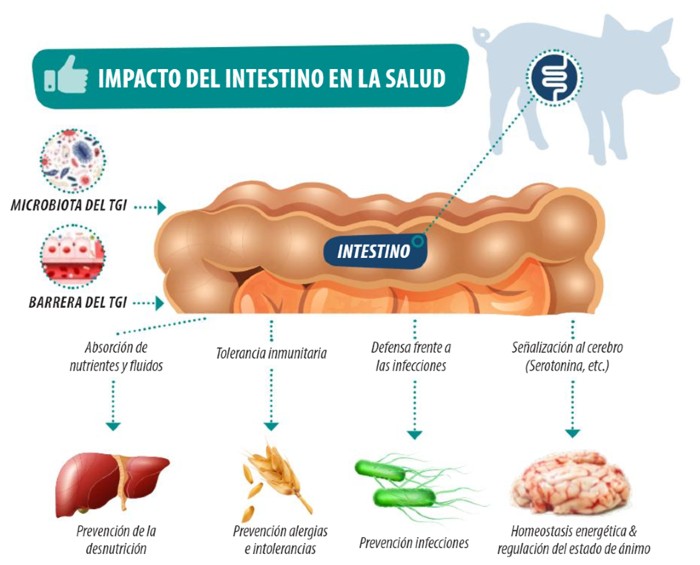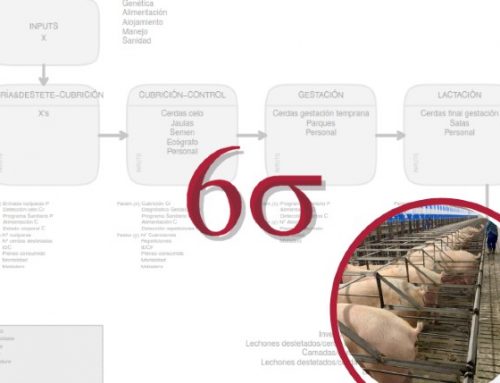Piglet gut health – insights and measurement
What is gut health?
In recent years, there has been an increase of the number of studies that define what “intestinal health” or “gut health” is. This is a consequence of the need to improve the productive performance of farm animals (growth, milk, meat and egg production), minimizing the cost of production and providing the highest possible level of animal welfare so that is accepted by the society.
The definition will depend on who we ask and what circumstance or factor we are referring to
Criteria for measuring Gut Health in piglets
Bischoff[1] proposes 5 criteria to measure intestinal health:
1 Effective digestion and absorption of nutrients, water and minerals.
→ Regular bowel movements, normal transit time, and no abdominal pain.
→ Normal consistency of stool (feces) and absence of nausea, vomiting, diarrhea, constipation and abdominal distention.
2 Absence of diseases in the (GI) gastrointestinal tract, without stomach diseases. Some examples could be ulcerations, carbohydrate intolerances, or enzyme deficiencies.
3 Normal and stable microbial flora, without abnormal growth of some bacterial species on others and without diarrhea associated with infections or parasites.
4 An effective immune state, with an effective function of the (GI) gastrointestinal barrier.
→ An effective and normal production of mucus and without bacterial translocations.
→ Normal levels of IgA, immunological tolerance and normal activity of the immune cells with absence of hypersensitivity of the mucosa.
5 A state of well-being. Although difficult to identify in production animals, it can be measured with normal serotonin levels and in the absence of stress markers.
The intestine also has an impact on the health of the individual:

Figure 1: The impact of the intestine on health: The gastrointestinal tract contributes to health by ensuring digestion and absorption of nutrients, minerals and fluids through various mechanisms. Among them, the induction of mucous membranes and systemic tolerance, the presence of defense systems against infections and other pathogens, and signaling from the periphery to the brain.
The function of the intestine is not limited to food processing and subsequent absorption of nutrients and fluids
Celi [8] states that there are 6 components that must be taken into account and studied to define intestinal health. They are all similar to what Bischoff takes into account with the sole exception that Celi incorporates diet that can be more easily manipulated and directed than in human gut health.
1 Diet where you have to consider the macro and micronutrients, the production-enhancing additives, the anti-nutritional factors of the different ingredients and the indigestible fractions.
2 An effective immune system.
3 Effective digestion and absorption.
4 A stable and effective microflora without overgrowth.
5 An intact intestinal mucosa with its mucous layer, epithelium, and associated lymphoid tissue.
6 Neuroendocrine and motor function of the intestine.
How can we measure intestinal health?
Varley, 2017 (comment in Pig Progress), defines that an animal that has good intestinal health must have a high correlation between general health and intestinal health, and therefore if:
that animal has or has had good intestinal health.
However, this way of evaluating must be associated with other series of values that measure the different components of intestinal health.
Measure gut health with in vivo techniques
Measuring intestinal health with in vivo techniques requires sophisticated methods, specific facilities, and specialized surgical technicians. It is also important to remarkt that it is not functionally viable. To measure intestinal health, it is proposed the use of biomarkers.
Biomarkers or biological markers are substances that can be used as a biological indicator. They must be able to be measured objectively and be indicators of a normal biological process, of a pathological state or as a response to a pharmacological treatment.
The development of biomarkers of the gastrointestinal functionality is crucial to advance to the understanding of events that affect the intestinal barrier, its functionality, and the ecology of the gastrointestinal microbiota. It might well be true that we currently have a deep knowledge of the digestive system and the absorption mechanisms of the main macro and micronutrients, but there is a large gap in research in relation to biomarkers of gastrointestinal permeability of gastrointestinal barrier function, of biomarkers for the intestinal endocrine system and of biomarkers that are indicative of the functional presence of beneficial microbiota or its metabolites.
Part II: Does the piglet gut health depend on the type and level of dietary fiber?
Article published in porciNews
Author: Morillo Alujas, Alberto
References
[1] Celi, P. et al. 2017, in “Gastrointestinal functionality in animal nutrition and health: New opportunities for sustainable animal production” Animal Feed Science and Technology 234 (2017) 88-100
[2] Bischoff, S.C. 2011. «“Gut health”: A new objective in medicine?» BMC Medicine 9-24.
[3] Blaut M, Clavel T: Metabolic diversity of the intestinal microbiota: implications for health and disease. J Nutr2007,137:751S-755S
[4] Vrieze A, et al.: The environment within: how gut microbiota may influence metabolism and body composition. Diabetologia2010,53:606-613.
[5] Sharma R, Young C, Neu J: Molecular modulation of intestinal epithelial barrier: contribution of microbiota.J Biomed Biotechnol2010,2010:305879.
[6] Chung H, Kasper DL:Microbiota-stimulated immune mechanisms to maintain gut homeostasis. Curr Opin Immunol2010,22:455-460.
[7] Tsurugizawa T, et al.: Mechanisms of neural response to gastrointestinal nutritive stimuli: the gut-brain axis. Gastroenterology2009,137:262-273.
[8] Celi, P. et al. 2017. «Gastrointestinal Functionality in Animal Nutrition and Health: New Opportunities for Sustainable Animal Production». Animal Feed Science and Technology 234 (diciembre): 88-100.
[9] Celi, Pietro, et al. 2018. «Biomarkers of gastrointestinal functionality in animal nutrition and health». Animal Feed Science and Technology, julio.





